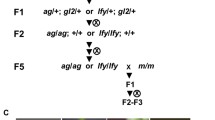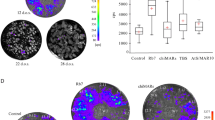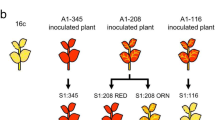Abstract
Transgene silencing in plants is most often dependent on homologous sequences, e.g. tandemly repeated T-DNAs. We have identified an Arabidopsis line (ex2–4 line 4) displaying silencing of the T-DNA-born nptII gene. This line contains a truncated copy of the T-DNA encompassing the nptII gene with its nos promoter adjacent to an intact T-DNA copy. The orientation of the intact and the truncated copies preclude the generation of a double-stranded nptII transcript. Therefore, we have investigated the genomic landscape surrounding T-DNA insertion in the silenced ex2–4 line 4 and five single-copy ex2–4 lines without silencing in search of features that might explain the silencing phenomenon. GC content, putative matrix-attachment regions and transcriptional interference from neighbouring genes could all be ruled out as major causes of silencing. Bisulphite sequencing revealed de novo methylation of the nos promoter both in non-silenced and silenced plants of this line, thus silencing was not correlated to DNA methylation level. Also, the methylation pattern deviated from that characteristic for RNA-mediated DNA methylation and silencing. Our data therefore suggest that ex2–4 line 4 represents a case where silencing is due to DNA-DNA pairing, i.e. pairing between the intact T-DNA and the adjacent truncated, inverted T-DNA copy.
Similar content being viewed by others
Abbreviations
- BVB:
-
binary vector backbone
- HGDS:
-
homology-dependent gene silencing
- MAR:
-
matrix attachment region
- nptII :
-
nopaline phospotransferase II
- nosp:
-
nopaline synthase promoter
- PTGS:
-
post-transcriptional gene silencing
- RNAi:
-
RNA interference
- TGS:
-
transcriptional gene silencing
References
Allen GC, Spiker S, Thompson WF (2000) Use of matrix attachment regions (MARs) to minimize transgene silencing. Plant Mol Biol 43:361–376
Aufsatz W, Mette MF, van der Winden J, Matzke AJ, Matzke M (2002a) RNA-directed DNA methylation in Arabidopsis. Proc Natl Acad Sci U S A 99:16499–16506
Aufsatz W, Mette MF, Van Der Winden J, Matzke M, Matzke AJ (2002b) HDA6, a putative histone deacetylase needed to enhance DNA methylation induced by double-stranded RNA. EMBO J 21:6832–6841
Cao X, Aufsatz W, Zilberman D, Mette MF, Huang MS, Matzke M, Jacobsen SE (2003) Role of the DRM and CMT3 methyltransferases in RNA-directed DNA methylation. Curr Biol 13:2212–2217
Cockerill PN, Garrard WT (1986) Chromosomal loop anchorage sites appear to be evolutionarily conserved. FEBS Lett 204:5–7
Day CD, Lee E, Kobayashi J, Holappa LD, Albert H, Ow DW (2000) Transgene integration into the same chromosome location can produce alleles that express at a predictable level, or alleles that are differentially silenced. Genes Dev 14:2869–2880
De Buck S, Windels P, De Loose M, Depicker A (2004) Single-copy T-DNAs integrated at different positions in the Arabidopsis genome display uniform and comparable beta-glucuronidase accumulation levels. Cell Mol Life Sci 61:2632–2645
De Wilde C, Podevin N, Windels P, Depicker A (2001) Silencing of antibody genes in plants with single-copy transgene inserts as a result of gene dosage effects. Mol Genet Genom 265:647–653
Eike MC, Mercy IS, Aalen RB (2005) Transgene silencing may be mediated by aberrant sense promoter sequence transcripts generated from cryptic promoters. Cell Mol Life Sci 62:3080–3091
Goubely C, Arnaud P, Tatout C, Heslop-Harrison JS, Deragon JM (1999) S1 SINE retroposons are methylated at symmetrical and non-symmetrical positions in Brassica napus: identification of a preferred target site for asymmetrical methylation. Plant Mol Biol 39:243–255
Iglesias VA, Moscone EA, Papp I, Neuhuber F, Michalowski S, Phelan T, Spiker S, Matzke M, Matzke AJ (1997) Molecular and cytogenetic analyses of stably and unstably expressed transgene loci in tobacco. Plant Cell 9:1251–1264
Ingelbrecht I, Breyne P, Vancompernolle K, Jacobs A, Van Montagu M, Depicker A (1991) Transcriptional interference in transgenic plants. Gene 109:239–242
The Arabidopsis Genome Initiative (2000) Analysis of the genome sequence of the flowering plant Arabidopsis thaliana. Nature 408:796–814
Jacobsen SE, Running MP, Meyerowitz EM (1999) Disruption of an RNA helicase/RNAse III gene in Arabidopsis causes unregulated cell division in floral meristems. Development 126:5231–5243
Jakowitsch J, Papp I, Moscone EA, van der Winden J, Matzke M, Matzke AJ (1999) Molecular and cytogenetic characterization of a transgene locus that induces silencing and methylation of homologous promoters in trans. Plant J 17:131–140
Kooter JM, Matzke MA, Meyer P (1999) Listening to the silent genes: transgene silencing, gene regulation and pathogen control. Trends Plant Sci 4:340–347
Kumpatla SP, Chandrasekharan MB, Iyer LM, Li GF, Hall TC (1998) Genome intruder scanning and modulation systems and transgene silencing. Trends Plant Sci 3:97–104
Larsen F, Solheim J, Kristensen T, Kolstø AB, Prydz H (1993) A tight cluster of five unrelated human genes on chromosome 16q22.1. Human Mol Genet 2:1589–1595
Lechtenberg B, Schubert D, Forsbach A, Gils M, Schmidt R (2003) Neither inverted repeat T-DNA configurations nor arrangements of tandemly repeated transgenes are sufficient to trigger transgene silencing. Plant J 34:507–517
Martienssen RA (2003) Maintenance of heterochromatin by RNA interference of tandem repeats. Nat Genet 35:213–214
Matzke M, Aufsatz W, Kanno T, Daxinger L, Papp I, Mette MF, Matzke AJ (2004) Genetic analysis of RNA-mediated transcriptional gene silencing. Biochim Biophys Acta 1677:129–141
Matzke MA, Aufsatz W, Kanno T, Mette MF, Matzke AJ (2002) Homology-dependent gene silencing and host defense in plants. Adv Genet 46:235–275
Mette MF, van der Winden J, Matzke MA, Matzke AJM (1999) Production of aberrant promoter transcripts contributes to methylation and silencing of unlinked homologous promoters in trans. EMBO J 18:241–248
Meza TJ, Enerly E, Børud B, Larsen F, Mandal A, Aalen RB, Jakobsen KS (2002a) A human CpG island randomly inserted into a plant genome is protected from methylation. Transgenic Res 11:133–142
Meza TJ, Stangeland B, Mercy IS, Skårn M, Berg A, Butenko MA, Haslekås C, Nymoen D, Håkelien A-M, Meza-Zepeda LA, Aalen RB (2002b) Analyses of single-copy Arabidopsis T-DNA transformed lines show that the presence of vector backbone sequences, short inverted repeats and DNA methylation is not sufficient or necessary for the induction of transgene silencing. Nucleic Acids Res 30:4556–4566
Muskens MW, Vissers AP, Mol JN, Kooter JM (2000) Role of inverted DNA repeats in transcriptional and post-transcriptional gene silencing. Plant Mol Biol 43:243–260
Pröls F, Meyer P (1992) The methylation patterns of chromosomal integration regions influence gene activity of transferred DNA in Petunia hybrida. Plant J 2:465–75
Qin H, Dong Y, von Arnim AG (2003) Epigenetic interactions between Arabidopsis transgenes: characterization in light of transgene integration sites. Plant Mol Biol 52:217–231
Schubert D, Lechtenberg B, Forsbach A, Gils M, Bahadur S, Schmidt R (2004) Silencing in Arabidopsis T-DNA transformants: the predominant role of a gene-specific RNA sensing mechanism versus position effects. Plant Cell 16:2561–2572
Stam M, de Bruin R, van Blokland R, van der Hoorn RA, Mol JN, Kooter JM (2000) Distinct features of post-transcriptional gene silencing by antisense transgenes in single copy and inverted T-DNA repeat loci. Plant J 21:27–42
Stam M, Viterbo A, Mol JN, Kooter JM (1998) Position-dependent methylation and transcriptional silencing of transgenes in inverted T-DNA repeats: implications for posttranscriptional silencing of homologous host genes in plants. Mol Cell Biol 18:6165–6177
Ulian EC, Magill JM, Magill CW, Smith RH (1996) DNA methylation and expression of NPT II in transgenic petunias and progeny. Theoret Appl Genet 92:976–981
van Leeuwen W, Ruttink T, Borst-Vrenssen AW, van der Plas LH, van der Krol AR (2001) Characterization of position-induced spatial and temporal regulation of transgene promoter activity in plants. J Exp Bot 52:949–959
Wang MB, Waterhouse PM (2000) High-efficiency silencing of a beta-glucuronidase gene in rice is correlated with repetitive transgene structure but is independent of DNA methylation. Plant Mol Biol 43:67–82
Yamada K, Lim J, Dale JM, Chen H, Shinn P, Palm CJ, Southwick AM, Wu HC, Kim C, Nguyen M, Pham P, Cheuk R, Karlin-Newmann G, Liu SX, Lam B, Sakano H, Wu T, Yu G, Miranda M, Quach HL, Tripp M, Chang CH, Lee JM, Toriumi M, Chan MM, Tang CC, Onodera CS, Deng JM, Akiyama K, Ansari Y, Arakawa T, Banh J, Banno F, Bowser L, Brooks S, Carninci P, Chao Q, Choy N, Enju A, Goldsmith AD, Gurjal M, Hansen NF, Hayashizaki Y, Johnson-Hopson C, Hsuan VW, Iida K, Karnes M, Khan S, Koesema E, Ishida J, Jiang PX, Jones T, Kawai J, Kamiya A, Meyers C, Nakajima M, Narusaka M, Seki M, Sakurai T, Satou M, Tamse R, Vaysberg M, Wallender EK, Wong C, Yamamura Y, Yuan S, Shinozaki K, Davis RW, Theologis A, Ecker JR (2003) Empirical analysis of transcriptional activity in the Arabidopsis genome. Science 302:842–846
Author information
Authors and Affiliations
Corresponding author
Rights and permissions
About this article
Cite this article
Skårn, M., Eike, M.C., Meza, T.J. et al. An inverted repeat transgene with a structure that cannot generate double-stranded RNA, suffers silencing independent of DNA methylation. Transgenic Res 15, 489–500 (2006). https://doi.org/10.1007/s11248-006-0019-y
Received:
Accepted:
Issue Date:
DOI: https://doi.org/10.1007/s11248-006-0019-y




